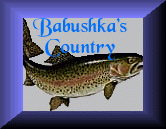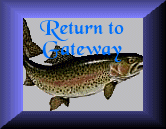Click here to listen to [Put Your Little Foot.mid]
Fish Traps
The men of Ninilchik built fish traps for commercial fishing. The lead was made of hand cut poles and web wire. The poles were placed in the ground during low tide in the early spring. Fish swam naturally along the shore and hit the lead. They instinctively followed the lead out towards deep water and into the heart. If the fish headed away from the heart they were guided back by the jiggers which extended like wings from either side of the heart. Jiggers were constructed of web wire and poles. The gates were closed during the fishing period and left open during closures. Gates were constructed of cotton and later nylon webbing. The fish swam through the tunnel into the pot, which was constructed of cotton or nylon webbing and poles, and could not find their way back out of the narrow tunnel. The beginning of the tunnel was approximately 10 to 12 feet wide and narrowed to approximately two feet. The trap was lifted at low tide. There were lines for loosening the tunnel and a dory was taken through the heart and into the pot. Salmon were pughed into the dory and taken out to the scow where they were stored until a fish tender arrived.
Although Fish Traps were an important industry to the people of Ninilchik they were outlawed after Alaska gained statehood in 1959. The abolition of fish traps was not actually a condition of statehood. The initiative question on fish traps was on the 1958 ballot--and their abolition coincided with statehood. Since then set nets and drift boats are in use.
Even though traps were outlawed statewide, they remain to this day in Metlakatla, an Indian Reservation, because the community remains under federal jurisdiction.
Poles For Fish Traps
There is a much history behind the building of fish traps. I interviewed three elders and the following are the results. From them I pieced together some of the life style of Ninilchik with only gathering of trap poles for a topic. The following information is courtesy of my grandmother, Sandra (Alexandra) Kelly Wells, the Eldest living person (age 93) raised in Ninilchik, Eleanor Cooper Beatty, her daughter, and George Jackinsky. You will notice a history change because my grandmother is at least twenty years older than the next storyteller. Fish poles were not an industry when she was young. They were gathered for personal use on traps. These are from tapes so words are the speakers own as much as possible with the only exceptions being a repeated sentence or word or where they restarted a sentence or got out of context. George Jackinsky also explains the construction of the dog sled used for hauling poles.
Sandra Wells (93 year old elder) information:
(She is speaking of how her brothers supported the family.) They all had good jobs in Libby's cannery and they had the fish traps then. Dad was bedridden for four years, I think, before he died. They went to work in the cannery like Dad did but they were not cooks. They were something else in the cannery. They cut the poles (towards spring) and they had the dog teams and bring them out from the woods by the bank on top of the hills you know by the bank. We used to go and take the bark off and let the poles dry out little bit you know for them boys you know. And then those boys will throw them poles down the bank into the river. They make a raft and they take them to the fishing grounds. In the fall of the year they let them go. Then in the fall of the year a big storm will come and they'll go down anyway and wash ashore and that will be the end of it.
Eleanor Cooper Beatty (my Mother)
This conversation was more of a question and answer type while I got a feel for the subject. I have found some speakers would rather answer questions while others are real storytellers. Both ways paint a picture or they may be more informed on other topics and will relate other types of stories. This session required prompting. Eleanor was better at putting stories in writing until her eyesight affected her ability to relate in this manner. This type of interview serves to give information so you will know the topic well enough to interview other speakers. My questions will be in parenthesis in the following dialogue.
(How you get across before the CC bridge to the beach?) Well, when the tide was out the boys would go across with rubber boots. (So when they wanted coal and wood from the beach they waited till the tide was out?) Well they'd have the dog team pull it. The dogs would be hooked up to be pulling the coal and stuff. Usually when the snow came, that's when they would really have to work and then they have to pull the poles down for making those traps. They'd get paid. The men would get paid for that. (Who were they selling them too?) Estes. (To the canneries?) Ya! (She has become silent. Spring of the year they made their money?) The spring of the year lots of money. (They made the poles during the winter?) Get them during the winter because on count of we could move them faster. You know get em down. They would be up on the hills like. They'd have to get em down. (And they just stacked them up or put them in the river? By where?) Usually close to the river. (So they would take all the limbs and everything off of the poles?) Oh ya. Sometimes they took em off right by where, you know, they cut em. So they wouldn't have too big of a mess. (All the men were doing this?) It depends on who got the contracts. (So they would get the contracts and would saw them by hand?) No they wouldn't. They would just clean them. (So how would they cut them down?) Axes. Cuz they had to be not too large so they wouldn't be to heavy. (So they would use the dogs to take them to the river?) uh hum. (So how would they move them from there?) Estes, you mean? Estes would have the boat tow em. He'd see that they got there. You had to have so many poles. They can't be broken or anything. You have to know what you are doing when you cut poles and sizes. Us kids would be allowed to bring them coffee or something like that. Grandma would let us do something like that. We would as to take them coffee or something so they could warm up. (pole cutters) Then I'd go home and bake a bunch of rolls. Hot rolls. (You would take them to them) Uh huh. It was my job to bake.
Now armed with information on the topic the third speaker being a male and understanding the subject better completely responds to the topic after I ask a few knowledgeable questions.
George Jackinsky
You cut Poles and haul them out you know for the fish traps. (Where did you go to cut them?) Out in the woods. Up Deep Creek River or Ninilchik River. I don't recall any specific spot. All I do remember was there is kind of a specific size like no more than four inches at the butt and stuff and I don't know maybe twenty, thirty feet long. They gotta be like a bamboo deal. All the kids would peel them. I peeled them. When they haul them all out, they haul them all out in winter. Come spring of the year the kids and the whole family would peel them. I remember out there when I was just a kid peeling tail ends of them. They haul them out with dogs. Bobsleds. A sled in the front and a sled in the back. It was a sled in front and there was a line. There was another sled in the back. What you call a Bobsled. If you picture a sled and if picture a line from the upper left-hand corner, the line would go to the upper right hand corner of the sled in the back. That would probably be about ten, fifteen, twenty feet behind. Whenever you would pull making a corner the opposite angle would pull. It was kind of a bobsled deal. Up in the front end of the sled there was a kind of a pivot. It was kind of a pivot angle. The poles and stuff would sit on top. If you make a turn up on top you would swivel. Very like a yoke up on top so the load would be up on top. So we would make a turn. It was all made out of wood so it's kind of like yoke with a knob down the middle. If you make a turn (like a bearing?) Right ya. (How many dogs would you use?) Five, ten, fifteen, twenty. Whoever had how many dogs. Shucks I can remember my family had nine dogs. (They just loaded them by hand onto this sled?) Right. (Where did they take those logs?) Usually towards the beach right to the tide water level. From then on they would handle them by hand. They were peeled at the tide water level. From then handling them by hand to the high water mark. At low tide they would make a raft and then tow them to the trap. (How would they raise that piling?) They would do it all by hand. (How many guys would it take to raise one pole?) I don't know. One, two, three four. They were relatively light by then. More like bamboo. You would have one guy at the butt and two three guys push it right up. Well they would drive a steel spike into the ground before they raised the poles. Drive a steel bar into the ground and then the steel bar would stick up a couple of two three feet above the ground level. After the pole was raised then they would drive the spikes around the steel and bend it. Then in the meantime while they raise it they would also tie the guys and steel guys and stuff up on top. So when they raised it the guys were up on top already. (I remember that. That was the wire that was holding it?) Right and then they'll pull the guys back. (That must have been hard?) Ya well the whole thing was. (Mom thought some of the guys in the village had a contract to cut poles?) Ya well they always did. Like Cook Inlet Packing Company, they would need so many trap poles. They had a contract I think for a dollar a pole. I think it was something like that. There were contracts for one hundred poles, two hundred poles or five hundred poles. That was kind of guaranteed money come spring of the year. You know they would sell the poles and stuff. I don't know how many they needed per trap. They must have things counted out. I supposed they figured the space, and the piling and the spikes. They knew exactly what they needed therefore they knew exactly what the contract was. (How did you deliver the fish?) The guys that had the contract with the trap also had the contract with the fishing company. They would also deliver the fish to the fishing company. The fishing company would come over and pick them up. They had a scow out there. I really don't know what the contract was. If I can think back they were being paid a percentage through the whole season. They didn't get it by the pound. They didn't get it per fish. They just got it per season. There was no incentive then because whatever you got didn't make any difference. There was mostly all trap fishing at that time. There was some set nets. As far as I can remember there was no boat fishing out there at all. It was after World War II. It was after Squeaky Anderson came in. He was the one who started the drift fleet. (There weren't very many Ninilchik men who were doing that?) They were all stabilized with set nets and trap fishing.
All further information and comments concerning fish traps are welcome. I especially would like to thank Senator Loren Leman of Alaska for his input on this subject, Harry Leman of Ninilchik for the use of his photograph and my husband for information on the building and functions of the trap.




